Exploring new career opportunities can raise a range of emotions and questions, particularly when it comes to experiencing inclusion and avoiding discrimination and judgement. Diversity, equity, and inclusion (DEI) matters because approximately 70% of the global workforce is made up of passive talent who aren’t actively job searching, and the remaining 30% are active job seekers. The addressable market is diverse, and your hiring efforts need to address the diverse market.
So, what challenges are faced by members of the transgender and gender-diverse community and how do we create more affirming and inclusive hiring experiences?
At Workplace Edit, we edit hiring practices and importantly, have the privilege of listening to Queer, Transgender and Gender-Diverse (TGD) people about what makes an inclusive experience.
Here are four ways to start making your hiring practices more inclusive:
- Educate yourselves
Invest in making your recruiters and hiring managers aware and trained on Queer, Transgender and Gender-Diverse (TGD) experiences, needs and opportunities. This includes providing training and ensuring they are measured on candidate experience as part of their targets or performance goals. If we are held accountable for the experiences we create (not simply the outcome of who we hire or how fast we hire them), we will prioritise making each person feel affirmed and included. Not all Transgender and Gender-Diverse colleagues or candidates are out at work, and no two people will have an identical journey or transition. So, remember to treat everyone uniquely, and without bias. Unfortunately, 1 in 3 UK employers say they wouldn't hire a transgender person according to a report by Black Trans Foundation UK so addressing management fear with training and clear expectations from senior executives is essential. Check out the amazing resources offered at Trans Hub as part of your learning journey. - Commit
Explicitly share your commitment to hire Transgender and Gender-Diverse candidates and show they are welcome and included at your workplace. Make this commitment and back it up with the data to show your understanding of why the commitments address the barriers and inequity in the world of Transgender and Gender Diverse folks. De-gender your targets, adverts and language. Use “they/them” as a default.
Ensure you have 40/40/20 targets, not 50/50 gender targets as nothing tells a non-binary colleague they aren't welcome in the exec team more than a target that literally denies their existence.
- Demonstrate
Show candidates rather than tell them. Transgender and Gender Diverse candidates have every right to be sceptical given the statistics and their experiences to date. Making a statement only goes so far unless it's backed up with action. At every point, a Transgender and Gender-Diverse candidate will be assessing the environment to ensure it's safe and you (as the recruiter or hiring manager) have a role to play in creating safe and inclusive spaces which means educating yourself.
On your careers page, adverts and key hiring process points advise candidates that they can access someone in your team who is trained and sensitive to the barriers Transgender and Gender-Diverse people face through the application process, and in work.
Map your hiring practice with Transgender and Gender-Diverse people who are willing to work with you and are compensated for their effort and contributions. They'll help you find the edits you need to make at every point in the hiring process.
- Be intentional
Whilst every experience is unique, many Transgender and Gender-Diverse people feel like they must rely on “luck” in every interaction. The luck being encountering allies who see their potential and treat them with respect.
The invitation to you all is to make sure you treat everyone with dignity and respect, so luck isn't the determining factor of their experience or job offer. Make sure every effort is made with Transgender and Gender-Diverse people and recognise there is no single Transgender and Gender Diverse experience as the community is as diverse as any community.
Respond to feedback and continue to show up, especially when you make a mistake.
If you are keen to be more inclusive for your Transgender and Gender-Diverse (TGD) employees, here are three types of “edits” we've supported within the hiring stage of the employee experience:
- Procedural Edit
This may include evaluating the gendered language used in your adverts using tools such as textio, providing a statement on your adverts and ensuring people leaders have access to toolkits, resources and training via organisations like Pride in Diversity and Minus 18. - Parallel Pipelines
When employees listen and understand the barriers for Transgender and Gender-Diverse people and create specific career attraction, mobility, and development programs, they start to level the playing field.
Where these initiatives focus on multiple barriers such as attracting women and Transgender and Gender-Diverse people who have been out of the workplace for 6 months or more, the benefits can be wide-reaching and consider intersectionality, which refers to the ways in which different aspects of a person's identity can expose them to overlapping forms of discrimination and marginalisation.
This type of focus can provide benefits in addressing intersectional inequities and provide the business with a unique talent pool who are usually discounted via traditional hiring approaches. - Hiring Reform
Broader reform requires assessing the purpose, role and aspiration of the hiring function which is more of a strategic activity. This requires the hiring function to ask themselves what their goals are, what they stand for and how their practices and actions drive or derail inclusion. They will then be able to re-organise their practices and systems around the experience and outcomes they are looking to create. This should specifically address the hiring function's role in reducing inequality and providing talented people to the company who will accelerate the business strategy.
What step will you take today to create an affirming, inclusive hiring experience for Transgender and Gender-Diverse (TGD) people?
Latest.

AI adoption failing isn’t the tech, it’s the people. How smart businesses overcome this.
Technology, Thought Leadership, Industry Trends

Temp-to-perm is the best way to hire today.
Hiring Insights

How to keep top talent: Strategies for successful onboarding
Hiring Insights, Ask Aquent, Training Resources




